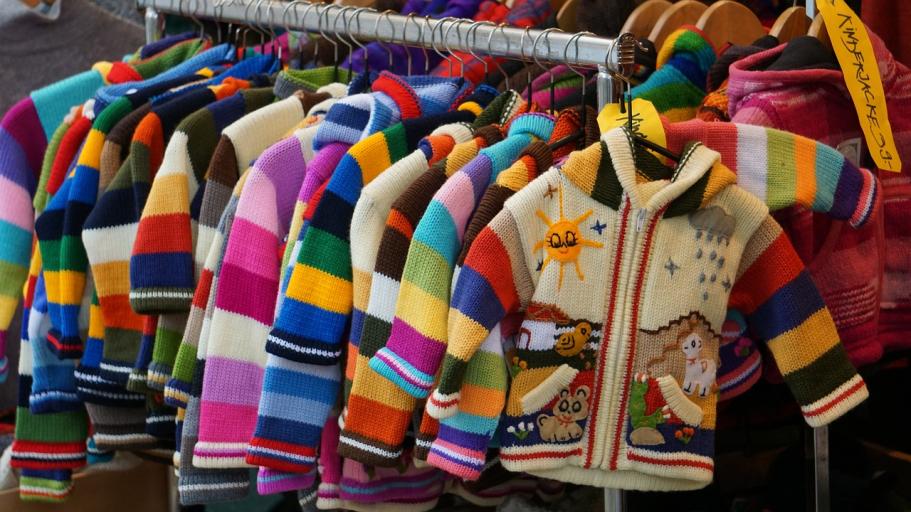Run a clothes swap

Clothes swapping is great way to get some new clothes and outfits in a cheap and more sustainable way. You can read more about the benefits of buying second hand clothing here.
While there are many ways to buy second hand, such as from charity shops, websites and apps, hosting a clothes swap can be a fun thing to do with friends or within your local community and can be something that’s run alongside an event or charity fundraiser. You can also run a clothes swap that focuses on a certain type of clothing that people might need, such as children’s clothing or school uniform. Here's how:
Where could I host a clothes swap?
- On your street – spread the word through your neighbourhood WhatsApp or Facebook group.
- At a lunch or party with your friends
- At your school fete or Christmas market
- At work, in your lunch hour or at a work event
Timeline
- At least 8 weeks ahead – start planning and assemble your team
- At least 7 weeks ahead – confirm the date and venue for your event, complete your risk assessment and confirm your insurance details (if needed)
- At least 6 weeks ahead – send a press release to local media outlets/parish magazines if needed, print off posters/leaflets and start distributing them
- At least 4 weeks ahead – start marketing online, send out information to key players in your local community making it clear wat you’d like them to do and how they can get involved. Include three top bullet points with ‘things to do’ in your communications
- At least 3 weeks ahead – post information on Facebook groups and any other online bulletin boards. Facebook buy/sell/swap groups are good to post to, and you could tweet local organisations and local press asking them to retweet. Word of mouth is the best form of advertising though so tell everyone you know about it!
- At least one week ahead – do daily social media posts, confirm the details with your venue and helpers (and check your helpers are still able to attend)
- The night before – do your final marketing push!
What equipment might you need?
- Clothes rails
- Tables
- Hangers
- Shoes racks
- Changing area
- Mirrors
- Music
- Decorations
- An A-frame board to advertise your event on the day
How will your clothes swap work?
- Some events charge for entry to cover the costs of hall hire and organising and some are free. Some swaps are used as fundraisers for charity
- Do you want to put a limit on the number of clothes to swap? If so, how many?
- You could rate items according to brand/quality although this will take extra time. If you use a rating system it could be: gold – designer items and expensive high street brands such as Whistles, Reiss, Finisterre and AllSaints. Silver – quality high street brands such as Marks & Spencer, Fat Face and Seasalt. Bronze – supermarket brands, Primark, New Look etc.
- Will you use tokens or just trust people to pick up the same amount of items as they dropped off?
- Will you ask for clothes to be dropped in advance or will you take them on the day?
- Specify the items need to be in good condition. You could also ask your local repair café to come along and help with any repairs at the same time as your swap
- It is best to sort items by size and perhaps also by garment type (shirts, trousers, tops etc)
- Don’t be afraid to refuse things that don’t meet the criteria and have a charity bag ready for these
- Towards the end of the evening, when everyone has finished swapping, you could make items available for sale – e.g. £3 - £5 per item
- If someone has brought more items than they’d like to take away, reassure them that the event has been for a good cause – reducing the amount of new clothes that are bought – and that remaining clothes will go to charity. If you know you’ll be running another swap, perhaps they can keep their tokens for next time and be given first choice!
Include the following information in your marketing:
- Clothing must be in good condition, i.e. not in need of repair, shrunk, stained, ripped, torn, missing buttons, sequins or beading, bobbly, discoloured or with broken zips
- Specify if the swap is specifically for adults or children and whether you are focusing on men’s or women’s clothes etc
- Specify if you will allow people to bring swimwear, shoes, underwear including tights/socks/leggings, nightwear, gym-wear and jewellery
- Who to contact for more information
Suggested event timings
- 3 hours before: clothing is dropped off and items are checked in by the clothes swap team, to check that they meet the criteria specified. Display items as they come in
- 30 minutes before: stop taking in clothing to allow a half an hour break before the start of the clothes swap to ensure everything can be hung up/put on display ready for opening
- Start time: open the doors! The event could last anywhere between 2-4 hours depending on your venue, the availability of help and your preference
- Finishing time: allow time to clear up depending on the size of your event. If you are taking care of leftover items, bag everything up ready to be taken to a charity shop or clothes bank